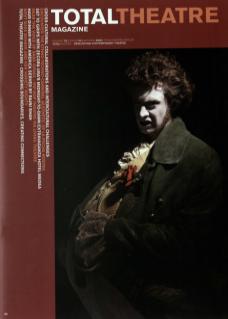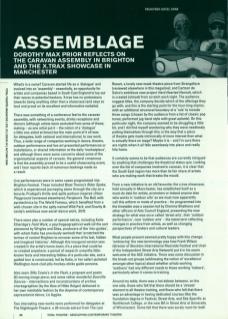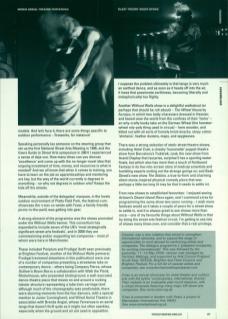What's in a name? Caravan started life as a 'dialogue' and evolved into an 'assembly’ – essentially, an opportunity for artists and companies based in South East England to lay out their wares to potential bookers. X.trax has no pretensions towards being anything other than a showcase (and says so loud and proud on its excellent and informative website).
There was something of a conference feel to the Caravan Assembly, with networking events, drinks receptions and dinners (although artists were excluded from some of these, making – as one artist put it – the notion of a 'dialogue’ a little one-sided at times) but the main point of it all was for delegates, both national and international, to see work. Thus, a wide range of companies working in dance, theatre, outdoor performance and live art presented performances or installations, or shared information at the daily 'marketplace', and although there were some concerns about some of the organisational aspects of caravan, the general consensus is that the assembly proved to be a useful showcasing event, and I hear reports back of numerous bookings made as a result.
Live performances were in some cases programmed into Brighton Festival. These included Blast Theory's Rider Spoke, which is experienced journeying alone through the city on a bicycle; Prodigal's thrills-and-spills parkour-inspired Urban Playground (reviewed elsewhere); Periplum's The Bell, with pyrotechnics by The World Famous, which benefited from a well-chosen site in the aptly named Wild Park; and Gravity & Levity's ambitious new aerial-dance work, Shift.
There were also a number of special extras, including Katie Etheridge's Field Work, a psychogeographical walk (of the sort pioneered by Wrights and Sites, producers of the 'mis-guides', with whom Katie has previously worked) that ‘scratched the tarmac of central Brighton to uncover some of its lost, hidden and imagined histories'. Although this inaugural version was created in the artist's home-town, it's a piece that could be recreated anywhere: a period of research unearths little known facts and interesting foibles of a particular site, and a guided tour is constructed, led by Katie, in her safari-jacketed Wellington-boot-clad jolly-hockey-sticks guide persona.
Also seen: Billy Cowie's In the Flesh, a poignant and poetic 3D moving image piece; and some rather wonderful Guerrilla Dances – interventions and reconstructions of archive choreographies (by the likes of Hilde Holger) delivered in her own inimitable fashion by the doyenne of contemporary expressionist dance, Liz Aggiss.
Two interesting new works were performed for delegates at The Nightingale Theatre: a twenty-minute extract from The Last Resort, a lovely new mask-theatre piece from Strangeface (reviewed elsewhere in this magazine); and Cartoon de Salvo's ambitious new project Hard Hearted Hannah, which is created (almost) from scratch each night. The audience suggest titles, the company decide which of the offerings they go with, and this is the starting point for the hour-long improv, with an additional structural boundary of a 'rule' to include three songs (chosen by the audience from a list of classic pop tunes; performed jug-band style with great aplomb). On this particular night, the company seemed to be struggling a little bit, and I did find myself wondering why they were needlessly putting themselves through this: is the way that a piece of theatre gets made intrinsically of more interest than what is actually there on stage? Maybe it is – and I'm sure there are nights when it all falls seamlessly into place and really hits home.
It certainly seems to be that audiences are currently intrigued by anything that challenges the theatrical status quo. Looking over the list of companies involved in Caravan, it is clear that the South East region has more than its fair share of artists who are making work that breaks the mould.
From a new initiative to an old favourite: the X.trax showcase, held annually in Manchester, has established itself as a must-do date for artists, promoters or indeed anyone else who works in 'outdoor arts' as we must now apparently call this artform or mode of practice – for programmed into the timetable was a session led by Chenine Bhathena and other officers of Arts Council England, presenting the new strategy for what was once called 'street arts', then 'outdoor performance', now 'outdoor arts' – the latest term reflecting changes in practice from artists, as well as changing perspectives of funders and cultural leaders.
Most people present seemed pretty happy with this change: 'embracing' the new terminology was how Frank Wilson (director of Stockton International Riverside Festival and chair of the Independent Street Arts Network) put it in his warm welcome of the ACE initiative. There was some discussion in the break-out groups (addressing the notion of 'excellence' amongst other topics) about whether artists working 'outdoors' had any different needs to those working 'indoors', particularly when it comes to training.
Around my table, there was a hot debate between, on the one side, those who felt that there should be a 'streets' element to all theatre training, and those who felt that there was an advantage in having dedicated courses (like the foundation degree in Festival, Street Arts, and Site Specific at Northbrook College, or the new BA in Street Arts at University of Winchester). Some felt that there was surely room for both.


